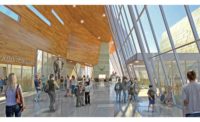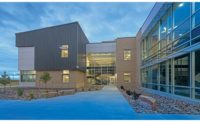Take a look at the website for civil and structural engineers Martin/Martin Inc., Lakewood, Colo., and you’ll see pictures of Jack Petersen, president, blasting down a rocky hillside on a mountain bike; Matt Schlageter, principal, lining up a putt; and Emily Guglielmo, principal, flying on a trapeze.
And you might ask: Don’t these folks ever work?
Well, yes—a lot, in fact. But the photos serve as a reminder that in the highly competitive world of consulting engineering, work-hard needs to be balanced by play-hard.
Guglielmo, a structural engineer who heads the firm’s San Francisco Bay Area office, says, “Consulting engineering is a really tough business. From a flexibility standpoint, you have clients, you have deadlines. We don’t always get to choose exactly what our daily schedule looks like. It takes very intentional effort to provide an employee an opportunity for flexibility.”
That “intentional effort” has paid dividends for both Guglielmo and the firm. A California native with degrees from UCLA and UC Berkeley, Guglielmo founded the San Francisco-area office after expressing a desire to return to the Golden State. Today, Martin/Martin’s West Coast portfolio is growing steadily, and her staff includes six structural engineers—as well as a team back in the firm’s Lakewood headquarters. Another Martin/Martin leader, Raleigh Fisher, recently relocated to Bentonville, Ark., and started an office there.
The 230-person firm’s expansion to seven offices across the Central and Western states helped it earn worldwide design revenues of $36.3 million in 2017. Of that, $30.46 million came from the Mountain States region, which prompts Petersen to say that there’s no place like home.
“Being in the Rocky Mountain region for the last three or four years has been the best place to be.”
– Jack Petersen, President, Martin/Martin
“Being in the Rocky Mountain region for the last three or four years has been the best place to be,” Petersen says. “We’ve had fantastic projects all over the place.”
Those projects include design work on the 43-story 1144 Fifteenth Street office tower, the fourth-tallest building in Denver; civil and structural engineering for the reconstruction and expansion of St. Joseph Hospital in Denver; involvement in Lockheed Martin’s $350-million Gateway Center in Littleton, Colo.; civil engineering for the redevelopment of Denver Water’s new operations complex in Denver; and civil and structural engineering for the recently completed Sonny Lubick Field at Canvas Stadium for Colorado State University in Fort Collins.
Petersen is especially proud of the St. Joseph and 1144 Fifteenth Street projects. Both required the innovation and problem-solving for which Martin/Martin is best known.
About the St. Joseph project, he says, “The civil engineering effort on that was enormous.” It included realignment of North Downing Street in Denver and reestablishing another thoroughfare, Humboldt Street, which had previously been interrupted by the medical campus. New construction on the complex included two post-tensioned parking garages and substantial utility work. Petersen says Martin/Martin’s relationship with the hospital, which stretches back 50 years, was instrumental to the project. It also included extensive remodeling, expansions and partial demolitions of numerous buildings in an overall restructuring of the medical campus.
At 1144 Fifteenth Street, civil engineering challenges included digging a two-story basement next to and under a neighboring high-rise and creating a stormwater vault and pumping system. And, Petersen adds, “The structural engineering for the lateral forces on a building that tall is pretty interesting.” The building’s crowned look required the exterior to slope inward beginning at around the 30th floor, he says. That necessitated a masterful use of geometry to create the unique angles in the building’s design.
The reality of civil and structural engineering is that the work is rarely seen in the finished product, with rare exceptions—arenas and stadiums, for example. In Martin/Martin’s case, says architect Peter Carlson of Denver’s Davis Partnership, that’s a shame.
“I think every once in a while, that it’s too bad we cover up their structure with architectural cladding,” Carlson says. “Because it, too, has a certain beauty and aesthetic appeal that is really wonderful.”
At the heart of architecture and engineering lies the need to understand what a building will be used for. At Lockheed Martin’s Gateway Center, which will produce space vehicles, Martin/Martin had to contemplate what the future role of the plant might be.
“Trying to stay ahead of what’s possible in spacecraft, and what’s going to be required for spacecraft, takes quite a bit of thought,” Schlageter says. Martin/Martin studied nearly 90 sites before recommending the one chosen in Littleton; among other things, the facility will include testing chambers that mimic the conditions of space.
Schlageter is also proud of Martin/Martin’s civil engineering work on Denver Water’s new 35.5-acre headquarters campus, which includes an administration building that he calls a “showcase of sustainability and innovation.” When completed next year, the building will have an onsite treatment plant that processes and recycles wastewater. In addition, the roof will send rainwater into a cistern; the water will be used for flushing toilets and for irrigation.
The building’s design required an amendment to Denver’s plumbing code, which didn’t include dual-piping for gray water. Schlageter says that by recycling wastewater, the “design competes” with the traditional intent of Colorado’s water laws, which typically allow customers to use water just once before passing it on to others. The idea, he says, is for Denver Water to show that water recycling can significantly benefit an arid state.
Testing new concepts is a tradition at Martin/Martin, founded in 1945 as Milo S. Ketchum Consulting Engineer. Petersen says one of Ketchum’s favorite expressions was, “Every idea deserves a decent burial.” Engineering ran in the Ketchum family. His father, Milo Sr., was dean of engineering at the University of Colorado Boulder in the early 20th century, and Martin/Martin retains a strong CU connection.
In addition to promoting new thinking, the company has a tradition of mentoring. Greg Gidez, director of design services for contractor Hensel Phelps, a longtime Martin/Martin client, says Petersen helped him immensely with his graduate thesis project at CU Denver. Martin/Martin employees, meanwhile, applaud the firm’s commitment to personal and professional growth. Moreover, Gidez says, in working with Hensel Phelps, Martin/Martin turned a traditionally adversarial relationship between engineers and contractors into a collaborative partnership.
Davis Partnership’s Carlson says his company’s decades-long collaboration with Martin/Martin has even turned into friendship—to the degree that the two firms worked together last month on a fundraiser for special-needs students in the Denver suburb of Arvada. Together, they sponsored a “sumo-wrestling night,” in which employees of the two companies donned air-filled sumo suits and went at it, to the delight of students, teachers and parents. There’s no word yet if photos will appear at the top of Martin/Martin’s website—but it’s not a bad bet that they will.








Post a comment to this article
Report Abusive Comment